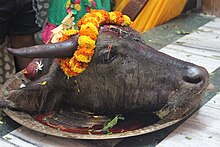Animal sacrifice in Hinduism
[2][3][4] The Hindu scripture Brahma Vaivarta Purana forbids the Asvamedha Horse sacrifice in this Kali Yuga.
[1][5] However, the perception that animal sacrifice was only practiced in ancient Non-Vedic Era is opposed by instances like Ashvamedha and other rituals that are rooted in Vedas.
[10] For instance, Sir John Woodroffe published a commentary on the Karpuradistotram, where he writes that the sacrificial animals listed in verse 19 are symbols for the six enemies, with "man" representing pride.
[11] The Brahmanic texts explicitly state that five creatures were suitable for sacrifice in Vedic India, in descending order: man, horse, cattle, sheep, and goat.
[13] The Ashvamedha, a ritual in which a horse was allowed to roam freely for a year, then finally sacrificed, is mentioned in the Vedic texts such as the Yajurveda.
[19] In Bhagavata Purana written in 6th to 8th century CE, Krishna tells people not to perform animal sacrifices in the Kali Yuga, the present age.
[26] Animal sacrifice is practiced in the states of Assam, Odisha, Jharkhand, West Bengal and Tripura in Eastern India, as well as in the nation of Nepal.
[31] In the state of Odisha, every year, animals like goat and fowl are sacrificed before Kandhen Budhi, the reigning deity of Kantamal in Boudh district, on the occasion of her annual Yatra/Jatra (festival) held in the month of Aswina (September–October).
[32] During the Bali Jatra, male goats are offered as a sacrifice to the goddess Samaleswari in her temple in Sambalpur, Odisha.
[33][34] Bali Jatra of Sonepur in Odisha, India is also an annual festival celebrated in the month of Aswina (September–October) when animal sacrifice is an integral part of the ritual worship of deities namely Samaleswari, Sureswari and Khambeswari.
[37] According to Christopher Fuller, the animal sacrifice practice is rare among Hindus during Navratri, or at other times, outside the Shaktism tradition found in the eastern Indian states of West Bengal, Odisha[38] and Northeastern India, Assam and Tripura.
[39][40][note 1] The Rajputs worship their weapons and horses on Navratri, and formerly offered a sacrifice of goat or male water buffalo to a goddess revered as Kuldevi – a practice that continues in some places.
[46] The tradition of animal sacrifice is not prevalent in temples and households around Banaras where vegetarian offerings are made to the Goddess.
[49] Animal sacrifice is also practiced by some rural communities around Pune to placate deities at temples of Waghjai and Sirkai.
[55] There is a general misconception that Vaishnava sect dedicated to the god Vishnu, which the majority of Hindus follow, prohibits animal sacrifice.
Ahobilam in Andhra Pradesh, is the centre of worship of Narasimha, the lion-headed avatar of Vishnu, to whom the nine Hindu temples and other shrines are all dedicated.
A popular Hindu ritual form of worship of North Malabar region in the Indian state of Kerala is the blood offering to Theyyam gods.





